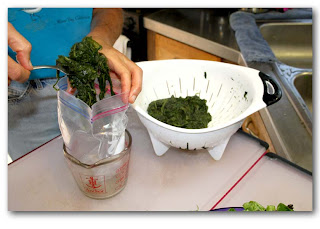We've all heard it hundreds of times, eating green leafy vegetables is one of the most important things you can do to get healthy and stay healthy. They are loaded with fiber, calcium, vitamins, vital minerals and antioxidants! For the first 22 years of our marriage we always had greens in the fridge knowing we needed to eat as much as possible but just how many damned salads can you eat? At least half the time they went bad before we could eat them.
When we became low fat vegans 5 months ago we decided to get serious about eating greens which called up memories of my grandmother who lived to be 91. She generally had year round gardens all her life and her winter garden always had a row of collard greens. When we visited she usually had a large pot of collards with ham hocks simmering on the stove. Grandma's collards have been my favorite food all my life but Kim & I seldom prepared them before we became vegan. Now greens are the nutrition centerpiece of our diet, we try to each eat at least ONE POUND per day of collards, kale, chard or spinach (we almost never eat lettuce because it has little nutrition value compared to the other greens).
Here's how we do it:
We buy greens from local organic farmers in bulk so we can get them at discounted prices. In order to preserve them we cook and freeze them in quart freezer bags.
Two large bowls of greens when cooked will fit in a one quart freezer bag which for us is one serving each:
All greens (no matter if the package says "Ready to Eat") should be thoroughly washed before eating raw. If pressure cooked, organic toxins like E. coli will be zapped; we pressure cook all our greens:
We load the pressure cooker and compact the greens moderately to get a good amount into each batch, over packing will result in uneven cooking:
Add 1/2 cup of water:
We use and recommend the Fagor 6 qt. Rapid Express pressure cooker (can be purchased at Bed, Bath & Beyond):
We allow the cooker to get up to pressure and keep it there 5 minutes for collards, 4 minutes for chard and kale, and 2 minutes for spinach. We put the cooker under a faucet running cold water to cool it down and bring the pressure down fast (also called rapid pressure release). Here's how the greens look after cooking under pressure:
We cool our cooked greens to speed up the process because we're usually processing 10 to 20 pound quantities:
We try to remove all excess water before freezing so when they're thawed for reheating it doesn't
dilute the sauce and spices we use to flavor them (it also requires less space in the freezer):
We load them into quart freezer bags:
As you can see our small freezer is loaded with greens! We're serious about our greens:
We can quickly thaw a 2 pound bag by submerging it in hot tap water for 5 minutes, then bring them to serving temperature in the microwave.
The traditional sauce to use on cooked greens in the Southeastern US is Pepper Sauce (peppered vinegar) which can be difficult to find in the western US. You can order it online or just do without the peppers and use white vinegar. Other vinegars work really well also: red wine, balsamic, rice, apple cider, etc.
Our favorite flavoring is a great ginger dressing that Kim makes (recipe here). As with most vegan dishes each person will have to experiment with different sauces and spices. Mike combines equal parts Bragg Liquid Aminos, ginger dressing, and pepper sauce for his greens. Kim just uses ginger dressing.














No comments:
Post a Comment